#andrées polar expedition
Text
On the topic of 19th century polar expedition were everyone are greatly unprepared for what they were actually doing
Well the original reason i started to look up different polar expeditions was because i stumbled over the swedish engeeiner Andrée attempt to reach the north pole in:
A hydrogen balloon!
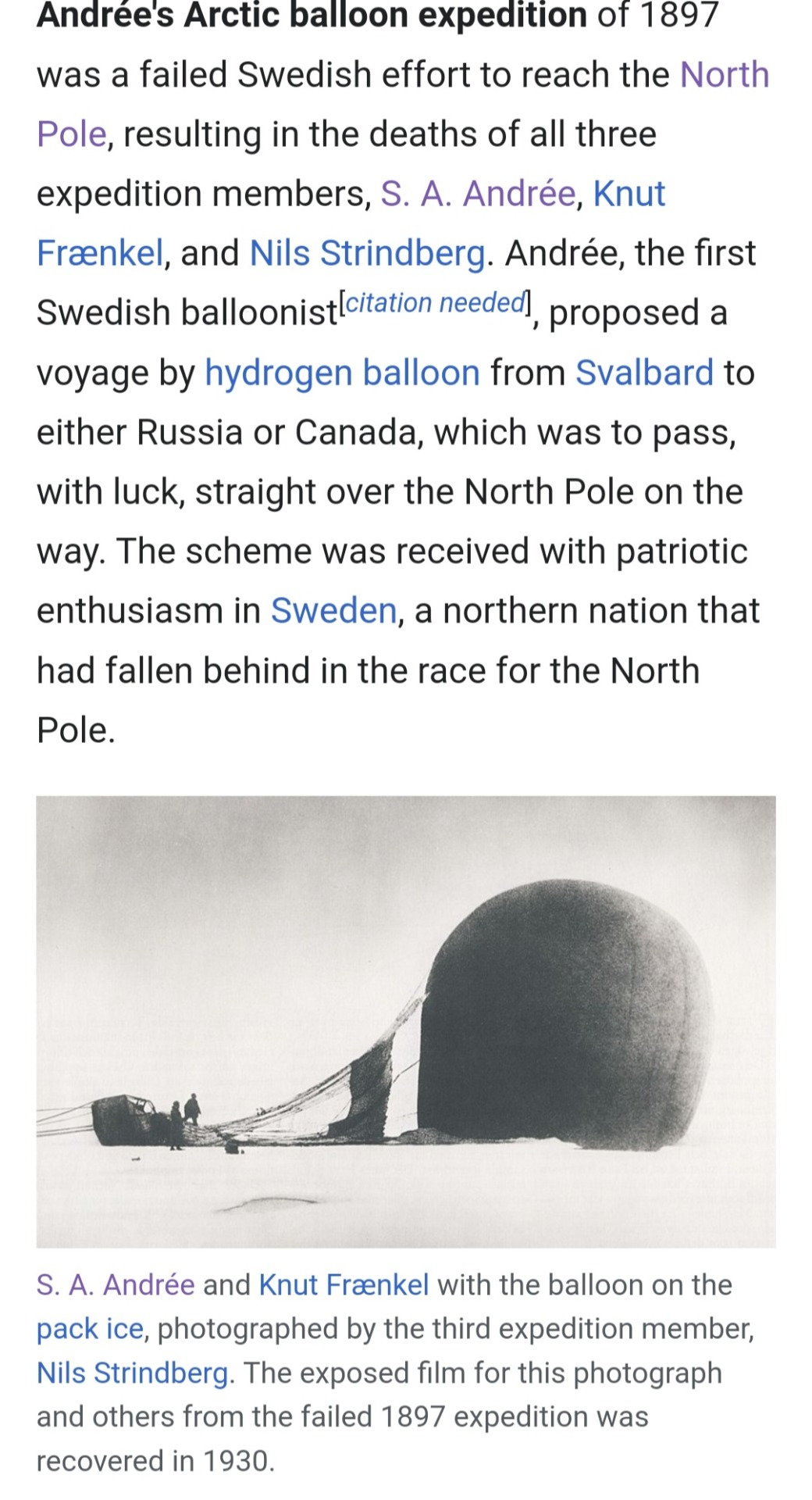
When the technology was new! And he knew very little about actually using the balloon. But he knew even less about the north pole.
They went in summer because:
1.
"The north pole got great weather in the summer for a balloon. Always sunny and and calm above the still ocean and smooth ice sheet"
(In reality summer means non stop fog and shifting winds. The ice sheet is melting and then freezing when the temp hovers around zero degress. This means it melts, moved and crashes into itself non stop.
The ice at the north pole is not you know. Anchored in land. Except at the edges were it sometimes reaches land. But in the summer it does not always reach land. So, no calm ice sheet, it is stormy broken landscape of arctic ocean with gigantic ice sheets crashing into eachother, breaking eachother, building up fun ice walls etc while the wind and oceans moves them around)
But! Andrée was gonna go with two lads across the north pole in a balloon.
2. Start in Svalbard and then just go were the wind takes them. Then he would land in "alaska, russia or canada" and just "walk to the nearest town and then take the train back to sweden idk"
(seriously his plan for post north pole flight was. Well i will be somewere in the arctic, i guess i will find humans and then go home?
At least, to his credit he knew and admitted that humans lived nearby the north pole, and he would be able to. Talk to them about how to get home. On the other hand, he was swedish so.... sweden has 30% of its surface within the polar circle. He started his travel from Norways Svalbard. So honestly, living in total ignorance of the people in northen sweden and norway would be absurd. And that it logically should be lots of people in equally northen places who knew in which direction the nearest train station/harbour were.
But! Some southern 19th century swedes would not have realised this so??? The bar is so low it have sunken to the south pole, but!)
But problem here is of course not that he gets that there are people to talk to when you have crossed the north pole. It is, that he do not grasp he might need to walk 1 week to reach these people. And what would our three stockholm dwelling southern swedes wear for their north pole expedition?
3. Normal southern swedish winter clothes! For you know around -10 to about -0 C. And living in a city were one can walk inside at any time.
Anyway their balloon crashed two days into the expedition on the that summer arctic ocean ice. And they needed to walk back to Svalbard archipelago.
It took 3 MONTHS. Because somehow Andrée had lived in denial that he might you know. Just crash into the arctic ocean. So all that. "I will just go the city and buy some coffee" planning did so not work out.
It took 3 months because Andrée and his two other expedition lads had no planning to actually needing to trek across the previously mentioned moving ocean ice. Also, the ice was as i mentioned MOVING.
Something they did realise. They did have all the academic skills in have to measure there movement across earth via stars, but not the.. pracitcal skills to solve how to get were they wanted to go.
Tbh i impressed that these 3 stockholm lads, all academic types, made it 3 months. What i mean is that, i would except most current day stockholmers to die much earlier tbh.
They also hunted polar bears like it is no big deal??? I mean they had guns so it was not difficult as such. But once again, tbh would expected my fellow stockholmers to be eaten earlier.
In general they appear to be good at hunting, which tbh finds interesting in contrast to other failed polar expedition were they run out of food. Perhaps swedens population having a hunting tradition were it was a important part for both getting food and the get money for ones household helped?
What i mean is that hunting was not just a upper class hobby as in some european countries at the time. It was just a normal way people got food.
Anyway, ones again the bar is low it sunk to the south pole haha. The 3 lads of Andrée expedition knew how to hunt and prepare wild animals. As the majority of people living within and near the polar circle
ANYWAY
In the end they did reached the Svalbard archipelago again. Finally not on moving ice anymore! But it was a remote island few ever visited... Shortly afterwards they all three die.
Exact cause of death is unknown, but personally i am surprised these 3 stockholmers even lived 3 months on sea ice?? 3 unprepared stockholmers? Like i am just like, obvoiusly they would not survive, there are so many things that can kill when you are just 3 indoor lads out in the arctic so....
We know all these details btw because in the 1930s the found the expedition and all there papers. And photos! Lots still able to be looked so
Anyway this was a rambling info dump of what i learned about the Andrée expedition these lasts days
#blogkeeping#andrées polar expedition#there are so much more things that made it obvoius this was so badly planned#and a unrealstic plan#doomed from the start!!#long post
22 notes
·
View notes
Text

489 notes
·
View notes
Text
i love it when you meet a stranger who's coincidentally on the exact same wavelength of insanity as you. i went to the library to return some books and mentioned to the guy at the front desk that i was interested in polar exploration history (specifically a book i was recommended the other day about an author's obsession with the failed andrée expedition) and i swear to god he lit up like a christmas light display as he pulled me around the shelves offering me every book they had on the subject and telling me to come back any time for more.
1K notes
·
View notes
Text
while im fond of polar expeditions in general andrées arctic balloon expedition will always have a special place in my heart. its just next level stupid, and that's how i like my polar expeditions <3
#history#polar expeditions#just winging it right until the end#you might not like it but this is peak dumbass polar exploration
2 notes
·
View notes
Text
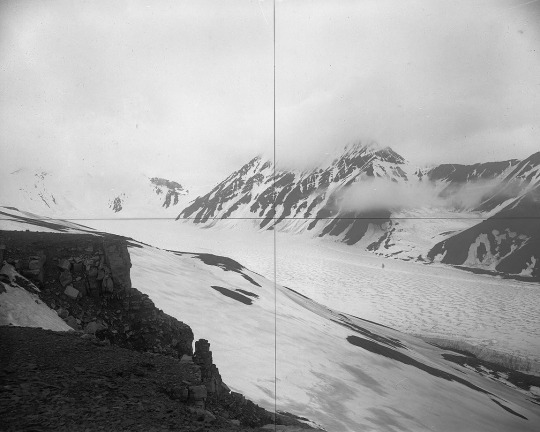
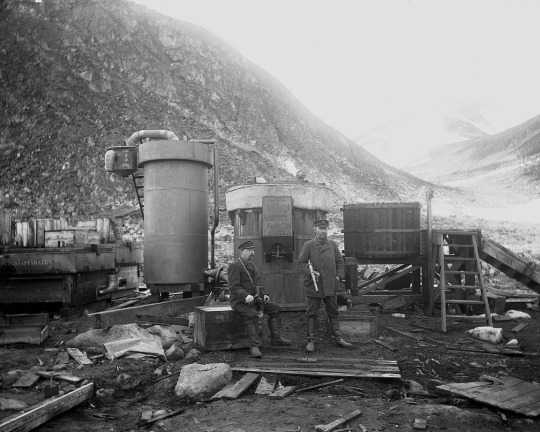
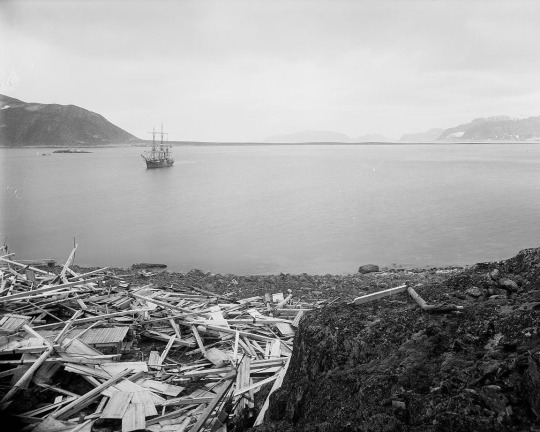
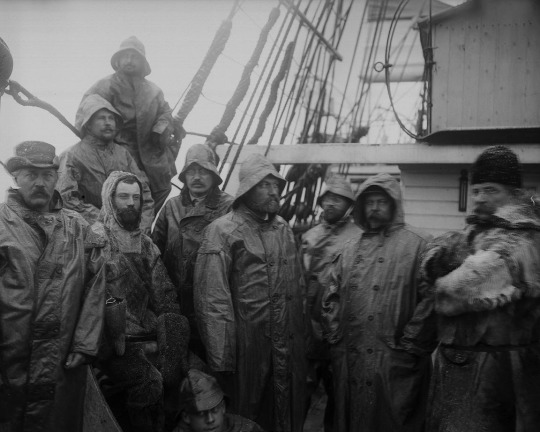

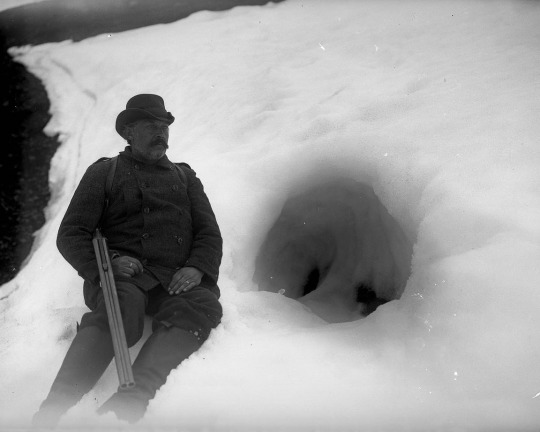


Various plates from Alfred Gabriel Nathorst’s Spitsbergen Expedition of 1898, as pictured by the Swedish mineralogist and photographer Axel Hamberg. By the time Nathorst reached these distant Arctic shores in the late 19th century, European explorers, scientists, whalers and trappers had already been voyaging here for over three centuries since the archipelago’s discovery in 1596 by the crew of the White Swan under the command of Dutch navigator Willem Barentsz. This is made all the more obvious by Hamberg’s pictures of graves as well as the abandoned launch site of S.A. Andrée’s doomed 1897 air-balloon expedition at Virgohamna on Danes Island.
While there is much vacant space in Hamberg’s views, the most interesting images are those that show the crew of Nathorst’s 1898 expedition in their comportment towards a polar horizon that remains all too human. Thus, just as in the photographs of similar expeditions from this period, Hamberg does not simply disguise Svalbard’s coastline as an immaculate ‘terra nullius’ of glaciers and snow-capped peaks, but recognises its landscape as a cultural ecology of desolation and wonder, grief and hope, peril and adventure, accomplishment and flounder. Amidst this far-flung horizon of rounded-points and about-turns, on this earth the perfect landscape does not exist. Hamberg does not pretend that it does.
Images available in the public domain, as sourced from the online Alvin National Digital Cultural Heritage Platform.
Found via Peter Holliday
29 notes
·
View notes
Note
whats the most unusual thing that got you inspired to write something?
i guess spite isn't unusual? it feels unusual to me still. it did push me to write a full novel but it's been rough editing that energy down to find a balance between i'm angry about how broken everything that was meant to support me is and like. more balanced character narration. i've written a few fics out of spite but i don't know if people could tell they were. (none in hsr tho.)
other than that i read a lot of non-fiction that inspires and informs me, and some of the odder ones have been the andrée polar expedition, the history of researching eels, i read a lot of what verso publishes which it can be the oddest sentence but it sparks an idea (there's a fic inspired entirely by a passage in how to be an anticapitalist in the twenty-first century by erik olin wright, but it's not a 1:1 but rather a train of thoughts clearly connecting them in my head, but probably not in anyone else's).
in real life, it's down to a lot of my walks. one time i went on a walk in a neighborhood nearby photographing brick walls and describing how they looked in writing. another i went down to the beach and walked it for two hours in december. i take long walks after dark and watch the city change. i ride the city buses and watch the streets.
#ask meadows anything#there's something about very present in your body as you are walking#taking in how it feels and how the air feels#that really truly resolves 89% of all writer blocks
3 notes
·
View notes
Text
One aspect of English romantic movement was to equate suffering with achievement. There was virtue in doing things hard way.
Roland Huntford "The last place on Earth". Well, spot on, Mr. Huntford, these ideas shine through the Scott's writings all the way. Though this brand of stupidity is not exclusive to British romantic movement, Polish romanticism was rife with that (with quite sad outcome for many people).
I find "The last place..." a fascinating read. Got completely absorbed with Amundsen's backstory, though I know it well, but Huntford knows how to tell a story. He is merciless though, both to Scott and to crumbling British Empire of Scott's era.
The tv series, based on Huntford's book, that premiered in the eighties was actually what introduced me to the stories of Scott and Amundsen when I was what... seven? And quite coincidentally )or maybe not) the scene that stuck in my memory for years was The Soldier, leaving the tent for the last time. Pity the actor who played Oates, Richard Morant, was so bland and uncharismatic, but I love Sverre Anker Ousdal as Amundsen (he was also great as Knut Frankel in Ingenjör Andrées luftfärd, a Swedish movie about the catastrophical polar balloon expedition by Andree), Martin Shaw as Scott, Sylvester McCoy as Birdie, Max von Sydow as Nansen (played Andree in the Ingenjör Andrées luftfärd, was absolutely delightful), Bill Nighy as Meares and last but not least Hugh Grant as Cherry.
Okay, I ranted enough, back to reading.
1 note
·
View note
Photo

Greetings Friends, I was so very lucky that almost 6 years ago being part of an expedition cruise organised by the by the Oceanwide Expedition Group to the North Pole. The Adventure started in Longyearbyen the town closest to the Pole. Here the visual impressions I've got touring this part of the world in June 2017. Arctic expeditions to Svalbard, i.e., Spitsbergen then and nowSvalbard has been the starting point for many expeditions. Some of these were historical voyages meant to reach the North Pole. Nowadays polar enthusiasts travel to Svalbard to see glaciers, tundra, and exotic wildlife. In Virgohamna, on the island of Danskøya, you can see the remains of several historic expeditions that used this remote bay as their basecamp. The most famous of these expeditions is that of Salomon Andrée, from 1897, the artifacts of which can still be viewed there. Obviously, our own Svalbard trips are much safer and more comfortable, giving you the chance to spot polar bears, walruses, whales, seals, and a wide variety of seabirds, and all while engaging in such immersive activities as shoreline hikes, kayak trips, Zodiac cruises, and more. #spitsbergen #svalbard #arctic #visitsvalbard #norway #longyearbyen #nature #mittsvalbard #travel #visitnorway #spitzbergen #naturephotography #svalbardlife #wildlife #polarbear #norge #landscape #expedition #unisvalbard #travelphotography #landscapephotography #svalbardposten #utno #arcticcircle #polar #auroraborealis #winter #snow #uwe_foto #uwewullfenphotography (at Longyearbyen) https://www.instagram.com/p/CpB1lUAsePU/?igshid=NGJjMDIxMWI=
#spitsbergen#svalbard#arctic#visitsvalbard#norway#longyearbyen#nature#mittsvalbard#travel#visitnorway#spitzbergen#naturephotography#svalbardlife#wildlife#polarbear#norge#landscape#expedition#unisvalbard#travelphotography#landscapephotography#svalbardposten#utno#arcticcircle#polar#auroraborealis#winter#snow#uwe_foto#uwewullfenphotography
1 note
·
View note
Quote
Like tiny specks of dark blue in an endless, hazy, ice waste, the three men hauled sledges that weighed far too much across hummocks, open channels and ice floes. Strindberg had written award winning essays about the conductivity of solutions after the addition of small quantities of non-conductive materials. Frӕnkel had specialist knowledge of railroad construction. Andrée had experience penning impassioned motions to the City Council on the topic of building subways underneath Stockholm in an effort to mitigate the city's unemployment levels. No one in the group knew anything about the one thing they needed now: how to survive in arctic conditions. They also knew nothing about glaciology, marine biology or marine chemistry. Nevertheless, they began collecting samples as soon as they landed, more or less at random.
Algae from blocks of ice and melt ponds were wrapped in gauze and packaged. They collected clay and sticks. The grain size composition of the clay was measured and recorded. They plucked out the eyes of a gull chick they shot so that someone at some point, someone else, with the required expertise, would be able to examine why gulls are unaffected by snow blindness. They took measurements and made drawings. Numbers were meticulously noted down in their logbooks in long, neat columns. They did and redid calculations. They held onto details, of the seemingly meaningless kind. Incredibly thorough research. Real, and yet, make-believe.
Bea Uusma, The Expedition: A Love Story: Solving the Mystery of a Polar Tragedy
4 notes
·
View notes
Text
The Andrée's Arctic Balloon

Photo: Perspektivet Museum
In 1897, a group of Swedish explorers went to the North Pole in an air balloon and disappeared. Their fate would not be known for 30 more years. Tendrils of this story can be found in the letters between Svante Arrhenius and Georg Bredig.
The Andrée's Arctic balloon expedition took place in 1897 in which S. A. Andrée, Knut Frænkel, and Nils Strindberg voyaged by hydrogen balloon from Svalbard in July 1897, the plan was to fly over the north pole, as a way to advance Sweden's place in the race to the north pole.
Svante Arrhenius tells Georg Bredig about his friend Strindberg’s impending expedition in a letter written only months before the expedition.
“Strindberg is supposed to leave his bride and travel with Andrée to the North Pole with the 4th version of the Perpetuum mobile (they leave on May 17th).” - Letter from Svante Arrhenius to Georg Bredig, May 1899
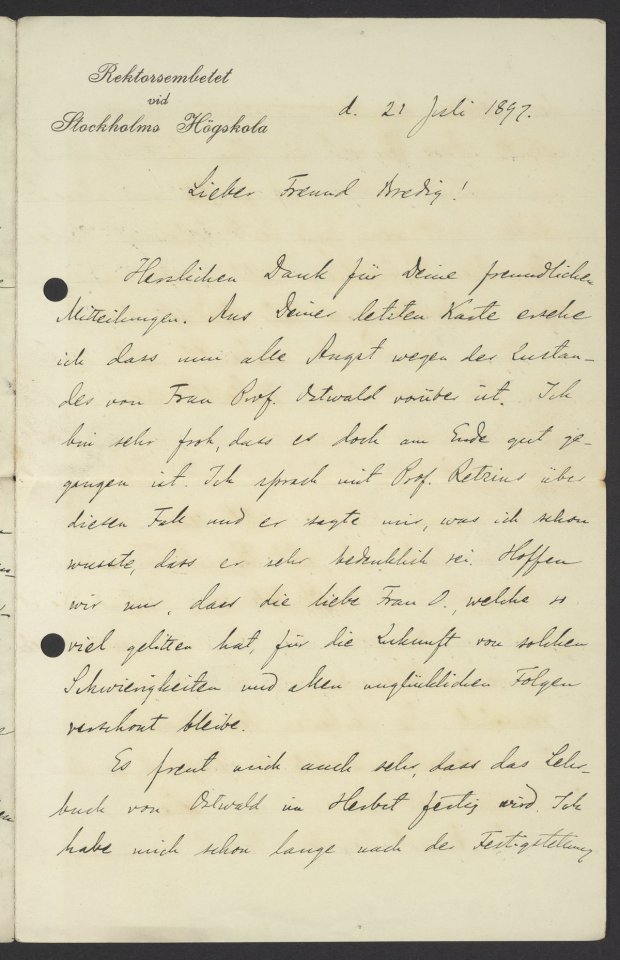
On July 21, 1897, Arrhenius wrote
“One topic of lively discussion here is the polar expedition and how its three explorers are faring. The trip may take a month or maybe even longer. Perhaps they are sitting in snowdrifts and cannot travel further. Such a situation must be unpleasant.”
Letter from Svante Arrhenius to Georg Bredig
Andree was Sweden's first balloonist and proposed the expedition. Fraenkel was a Swedish engineer and Strindberg was a Swedish scientist and photographer. Unfortunately, the expedition was not completed and all three expedition members perished.
The balloon quickly lost hydrogen within the first two days of the expedition and crashed into a pack of ice, leaving the explorers in Svalbard. In October 1897 the three men made it to Kvitøya (White Island) in Svalbard. The island is almost completely covered in an ice cap and uninhabited. The three men were not able to survive the harsh arctic weather and perished.
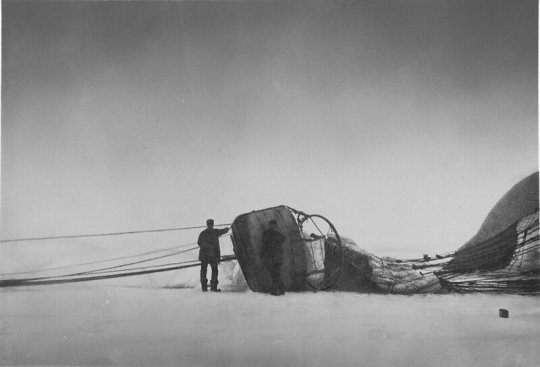
Posing with the wreck (via Tekniska museet)
No one knew the fate of the explorers until August 5, 1930, when, due to a particularly warm summer, sealers could access the island. There they found the remains of the three men, their boat, journals, and exposed rolls of film that Stringbeg had taken. 93 photographs were able to be developed.
The photographs capture the balloon’s crash and the months following. The photographs show the camps they set up, hunting polar bears, and other realities of living in the arctic.

Photo: Neil Strindberg
To see more photos that have been developed visit
To learn more about the Papers of Max and Georg Bredig visit the Technical Museums Flickr
#photography#history#archives#exploration#arctic exploration#S. A. Andrée#Nils Strindberg#Knut Fraenkel#svalbard#Nils Gustaf Ekholm#othmeralia
89 notes
·
View notes
Audio
Void of Silence - The Sky Over (June 11th, 2018)
Eight years have passed, and many thought the Italian doom pioneers were gone for good. Void Of Silence though are back with a new, complex, solemn doom metal album, their fifth in a nineteen year-spanning career. The trio hailing from Rome has been on hiatus for the last eight years, and is now about to publish the next chapter in their story.
The Sky Over continues Void Of Silence tradition of a majestic, keyboard-oriented doom metal with clean and airy vocals. This personal style of doom metal is built upon three main tracks lasting over 15 minutes each, intertwined with shorter, minimal interludes flirting with dark ambient sounds. Soi’s emotional voice is on top of monumental riffs and deep drum beats, and synths and keyboards embrace the whole.
The concept behind this record both musically and lyrically, in the words of mastermind Riccardo Conforti, “is focused on the great human achievements of the early twentieth century, and the fiery courage of those few men whose bravery led them to set their limits far beyond humanity’s fragile horizons. Aviators and their zeppelins, the great polar expeditions, the epic journey of the Airship “Italia” led by Umberto Nobile and the tragedy of the Red Tent. The unbelievable resilience of Salomon August Andrée and his men, who traveled through the merciless vastness of the Pack, without ever turning back. The cold and blinding light that reverberates from the glacial regions as the only guidance that accompanied them until the end, is what we tried to portray. This is our tribute to them.”
#Void of Silence#Funeral Doom Metal#Doom Metal#Dark Ambient#Luca Soi#Ivan Zara#Riccardo Conforti#Italy
6 notes
·
View notes
Photo
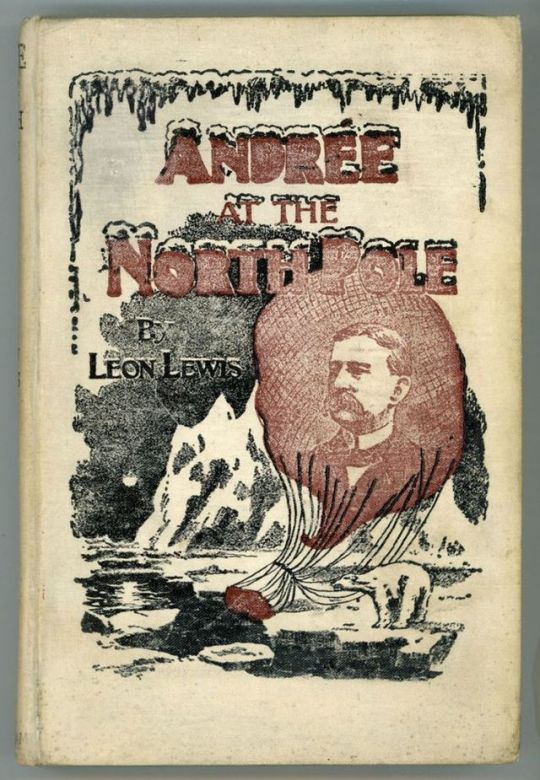
Andrée at the North Pole, with Details of his Fate. Leon Lewis. New York: G. W. Dillingham Co., Publishers, 1899. First edition, probable first binding.
The more elaborate binding with illustration on front cover with Andrée's face on a balloon and a polar bear on an ice flow. Andrée's expedition departs by balloon from Dane's Island in 1897 and, after a series of aerial adventures, the explorers arrive in the Kingdom of Polaris, an unknown land near the North Pole inhabited by a white race which is scientifically ahead of the outside world.
10 notes
·
View notes
Text
Everyone please send me memes abt S.A Andrées polar expedition I need it to cure my depression
4 notes
·
View notes
Photo
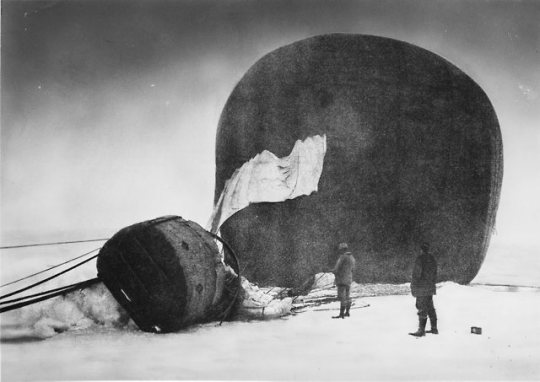
Nils Strindberg. Airballon 'Eagle' after landing in on the ice in Spetsbergen. S.A. Andrées polar expedition. 14th of july 1897
[::SemAp Twitter || SemAp::]
#BW#Black and White#Preto e Branco#Noir et Blanc#黒と白#Schwarzweiß#retro#vintage#Nils Strindberg#airballon#Spetsbergen#S.A. Andrées#1897#1890s#19th Century#XIX Century#Neunzehnten Jahrhundert#XIXe siècle#Século dezenove#19世紀
57 notes
·
View notes
Text
Five Interesting Nonfiction Books
1. The Expedition: Solving the Mystery of a Polar Tragedy by Bea Uusma
On July 11th, 1897, three men set out in a hydrogen balloon bound for the North Pole. Led by engineer August Soloman Andrée, they want to make history, but are frighteningly underprepared. Three days into their journey they make a crash landing and disappear into a white nightmare. They never return. 33 years later. The men's bodies and equipment are found buried beneath the snow and ice on a deserted glacier. They had enough food, clothing and ammunition to survive. Why did they die? 100 years later. Artist and doctor Bea Uusma is at a party. Bored, she pulls a books off the shelf. It is about the Andrée Expedition. For the next fifteen years, Bea will think of nothing else... This is her journey to uncover the truth. (Goodreads.com)
2. A History of the Swedish People by Vilhelm Moberg
Beginning in prehistoric times and culminating with the Dacke rebellion of 1542, renowned novelist Vilhelm Moberg's two-volume popular history of the Swedish people approaches its subject from the viewpoint of the common people, documenting peasants' lives as well as those of the royal families. In this first volume Moberg examines Viking raids, the coming of Christianity, and the Folkungs royal dynasty, whose tyrannical reign lasted from 1250 to the 1360s. He vividly describes the arrival of the Black Death from a ship that docked carrying only dead passengers, and he recounts the reign of Queen Margareta who founded the Kalmar Union, comprising all of Scandinavia. In every chapter, Moberg faithfully imparts how history affected "the whole people" of Sweden. (Amazon.com)
3. Fishing in Utopia by Andrew Brown
From the 1960s to the 1980s, Sweden was an affluent, egalitarian country envied around the world. Refugees were welcomed, even misfit young Englishmen could find a place there. Andrew Brown spent part of his childhood in Sweden during the 1960s. In the 1970s he married a Swedish woman and worked in a timber mill raising their small son. Fishing became his passion and his escape. In the mid-1980s his marriage and the country fell apart. The Prime Minister was assassinated. The welfare system crumbled along with the industries that had supported it. 20 years later Andrew Brown traveled the length of Sweden in search of the country he had loved, and then hated, and now found he loved again. (Amazon.com)
4. The Palace of the Snow Queen: Winter Travels in Lapland by Barbara Wilson
A Frequent traveler to Northern Europe, Barbara Sjoholm set off one winter to explore a region that had long intrigued her. Sjoholm first travels to Kiruna, Sweden, to see the Ice Hotel under construction and to meet the ice artists who make its rooms into environmental art. Traveling to the North Cape, she encounters increasing darkness and cold, but also radiant light over the mountains and snow fields. She crosses the Finnmark Plateau by dogsled, attends a Sami film festival (with an outdoor ice screen), and visits Santa's Post Office in Finland. Over the course of three winters, Sjoholm unearths the region's rich history, including the culture of the Sami. As Sjoholm becomes more familiar with Kiruna, she writes of the changes occurring in northern Scandinavia and contemplates the tensions between tourism, the expansion of mining and development of the Ice Hotel, and age-old patterns of land use, the Sami's struggle to maintain their reindeer grazing lands and migration routes. (Amazon.com)
5. Lagom: The Swedish Art of Balanced Living by Linnea Dunne
The Swedish concept of Lagom (pronounced "lah-gom") roughly translates to "not too little, not too much, just right." This charming book introduces readers to a new way of balanced living that promises happiness and sustainability in work and in life. Lagom provides simple solutions to juggle everyday priorities, reduce stress, eat well, and save money, with lessons on the importance of downtime, being outdoors, and Sweden's coffee break culture. Tips on removing clutter and creating a capsule wardrobe help readers achieve Sweden's famously clean and functional design aesthetic, while advice on going green and growing food gets their hands dirty. (Goodreads.com)
1 note
·
View note
Text
Frozen shipwreck reveals new details of John Franklin’s tragic 1845 Arctic voyage
(CNN) — Researchers in Canada have launched new pictures of a remarkably well-preserved shipwreck that may shed new mild at the ill-fated 1845 Arctic expedition wherein famed British explorer John Franklin died.
The break of HMS Terror has successfully been “frozen in time” because of the chilly, deep waters of Terror Bay in Nunavut, Canada, and a layer of silt which has preserved artifacts comparable to maps, logs and medical tools, in step with a find out about through Parks Canada along with Inuit researchers.
HMS Terror and HMS Erebus activate from England in 1845 in seek of a course around the North-West Passage however were given caught in sea ice, forcing the 129 team individuals to desert send in 1848. The males died one at a time making an attempt to stroll to protection around the Arctic.
Photos and video pictures have been accrued the use of a remotely operated car (ROV), in what the company describes as “one of the largest, most complex underwater archaeological undertakings in Canadian history.”
Researchers used the ROV to discover 20 cabins and compartments at the send, the primary time the internal of HMS Terror were systematically explored, in step with a Parks Canada remark.
Artifacts were effectively preserved because of the chilly water, lack of herbal mild, and a layer of silt.
Ryan Harris/AFP/Getty Images
“The impression we witnessed when exploring the HMS Terror is of a ship only recently deserted by its crew, seemingly forgotten by the passage of time,” stated ROV pilot Ryan Harris.
The group were given pictures from over 90% of the send’s decrease deck, together with residing quarters.
The captain’s cabin is the largest treasure trove – and in addition the most productive preserved phase of the decrease deck – with closed map cupboards, a tripod and a couple of thermometers already recognized.
Behind a closed door lies the captain’s napping quarters, the one phase of the decrease deck that archeologists may no longer discover.
The group believes that written paperwork can have been preserved for the reason that water temperature is 0 levels Celsius or decrease, there’s no herbal mild, and sedimentation is helping to maintain natural subject matter comparable to paper through making for an atmosphere the place much less oxygen is provide.
Underwater archeologists stated the findings surpassed expectancies.
Ryan Harris/AFP/Getty Images
Marc-André Bernier, supervisor of underwater archeology at Parks Canada, stated the situation of the captain’s cabin very much surpasses expectancies.
“Not only are the furniture and cabinets in place, drawers are closed and many are buried in silt, encapsulating objects and documents in the best possible conditions for their survival,” stated Bernier in a remark.
“Each drawer and other enclosed space will be a treasure trove of unprecedented information on the fate of the Franklin Expedition.”
Researchers will now analyze the discoveries on HMS Terror so as to acquire a greater working out of what came about on board the send, and hope to ultimately construct an image of the lives of person team individuals.
“The excellent condition of the ship will, I hope, mean that there will soon be answers to so many questions about the fate of the Franklin Expedition, shrouded in mystery since 1845,” stated Susan Le Jeune d’Allegeershecque, British High Commissioner to Canada.
Canada and the Inuit will collectively personal the new-found artifacts from HMS Terror and HMS Erebus below a 2018 settlement.
HMS Terror was once noticed at the sea mattress off King William Island in September 2016, and HMS Erebus was once present in September 2014.
Franklin’s ultimate expedition was once “the worst disaster in the history of British polar exploration,” in step with the Royal Museums Greenwich.
from Moose Gazette https://ift.tt/2zxx22L
via moosegazette.net
0 notes